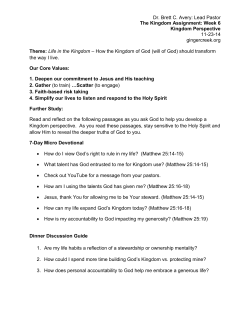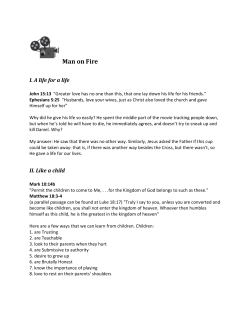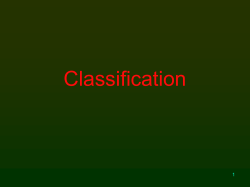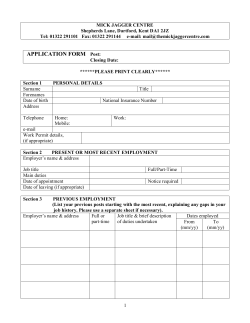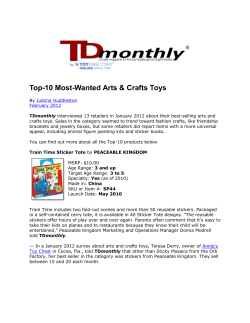
Five Kingdoms of Living Things
Five Kingdoms of Living Things Scientists divide all living things into 5 Kingdoms: 1. 2. 3. 4. 5. Protista or Protoctista Monera Fungi Plant Animal The 5 Kingdoms 1. Taxonomy a. the science of identifying, naming, and classifying 2. Classification a. the act of placing objects in groups based on characteristics 3. Scientists use both of these to organize living organisms. 4. The largest group living things are placed in is a kingdom (there are 5). 5. The smallest classification group is the species. The second smallest is the genus. Protista: • Complex, single-celled life forms (eukaryotic) • Usually can only be seen through a microscope paramecium • Can be parasites that cause disease amoeba • Can make its own food or feed on other living things • A protist has a nucleus. • Examples: amoeba, paramecium, simple algae Monera: • Simple single cells (prokaryotic) • Shaped like rods, spirals, and round balls • So small they can only be seen through a microscope • No nucleus! • Example: bacteria Bacteria Bacteria • Harmful Effects – Diseases – Bad Breath – Acne • Benefits – Food Production – Digestion – Waste treatment Protista and Monera Prokaryotic (simple) monera Most are single celled Producers Or consumers living No nucleus Eukaryotic (complex) Bacteria protista Has a nucleus Examples: Kelp, ameba, paramecium Fungi: • Multicellular organisms • Absorb food from living or dead things (consumers). • Parasitic “plants” (They are not true plants because they do not have chlorophyll to make their own food.) • Examples: mushrooms, bread mold, penicillin, mildew, and yeast Plants: • Multicellular organism • Contain chlorophyll used to make their own food (producers) and gives them a green color (photosynthesis) • Have cell walls Kingdom Plantae Flowering plants Non-flowering plants Flowering plants • Have roots, stems and leaves • Reproduce by seeds • Produce seedbearing fruits Non-flowering plants Mosses and liverworts Ferns Gymnosperms • Have no true roots, stems or leaves • Reproduce by spores • Spores are found in capsules • Have roots, stems and leaves • Reproduce by spores • Spores are found on the underside of leaves • Have roots, stems and leaves (needle-like) • Reproduce by seeds • Seeds are not found in fruits, by in cones • E.g. Red moss, Leucobryum glaoum, Diphyscium foliosum • E.g. Stag’s horn fern, Bird’s nest fern • E.g. pine, white spruce Animals: • Divided into 2 main groups: 1. Invertebrates: animals without backbones 2. Vertebrates: animals with backbones Vertebrate Invertebrate Have backbones Some have an exoskeleton Vertebrates Have an endoskeleton Endo means inside Invertebrates No backbones Exo means outside Fish Physical features: a. Fins b. Gills c. Cold-blooded d. Scales Classification Groups: Animal Kingdom, Vertebrates Facts: Fish breathe. Fish lay eggs. Amphibians Physical Features: 1. Moist, slimy bodies 2. Live on land AND in water 3. Breathe with gills as well as lungs (sometimes in different stages of life) 4. Cold-blooded Classification Groups: Animal Kingdom, Vertebrates Facts: They lay eggs in moist places. They may have gills that develop into lungs. Reptiles Physical Features: 1. Dry, scaly skin 2. Cold-blooded 3. Breathe with lungs 4. Spend most of their time on land Classification Groups: Animal Kingdom, Vertebrates Facts: There are 4 types: lizards, snakes, turtles, and alligators/crocodiles. Most lay eggs. Birds Physical Features 1. Warm-blooded 2. Covered with feathers 3. Live on land, in trees, & on water 4. Don’t have front legs 5. Have wings 6. Have short, soft feathers called down Classification Groups: Animal Kingdom, Vertebrates Facts: Birds have beaks. Most fly. Few live in cold weather. They have hollow bones. Some have webbed feet. Mammals Physical Features: 1. Warm-blooded 2. Have hair/fur to keep warm 3. Breathe with lungs 4. Give birth to live young, lay eggs, or have babies in pouches (marsupials). 5. Feed or nurse their young (milk glands) 6. Can be carnivores (meat eaters), herbivores (plant eaters), or omnivores (plant/meat eaters) Classification Groups: Animal Kingdom, Vertebrates Facts: 1. Keep steady body temperatures. 2. Some have fat/blubber to keep warm (whales). 3. We are mammals! 4. Temperature does not affect their activity levels. Sponges Physical Features: 1. Live in water. 2. Have no heads or faces. 3. Have small openings, or holes (for breathing). Classification Groups: Animal Kingdom, Invertebrates Facts: Sponges are the simplest invertebrates. Most sponges in kitchens are artificial. Mollusks Physical Features: 1. Have soft bodies like worms. 2. Some have a mantel (hard protective covering). A snail does; an octopus does not. 3. Some have a strong muscular foot (not feet— just one foot). Classification Groups: Animal Kingdom, Invertebrates Facts: There are 3 types: snails, scallops, and octopus. They are found in fresh/saltwater or on land. Spiny-Skinned Animals Physical Features: 1. Have spines that cover their bodies. 2. Have tube feet. Classification Groups: Animal Kingdom, Invertebrates Facts: They live in oceans. They can pull off a scallop’s shell to eat the soft animal inside! Hollow-Bodied Animals Physical Features: 1. Have a hollow center lined with digestive cells. 2. Have tentacles with sting ray cells. 3. Have a mouth. Classification Groups: Animal Kingdom, Invertebrates Facts: ERT find out characteristics of this animal group. Flatworms & Roundworms Physical Features: 1. They feed on other plants or animals (parasites). 2. Can be round or flat. Roundworms live in soil. Flatworms live in salt/freshwater. 3. Flatworms have one hole. Roundworms have two. Classification Groups: Animal Kingdom, Invertebrates Facts: They are more simple than segmented worms. Tape worms can grow up to 72 feet! Segmented Worms Physical features: 1. Have two openings for digestion. 2. Have a segmented body. 3. Have a brain, heart, and blood. Classification Groups: Animal Kingdom, Invertebrates Facts: They are found in soil or fresh/saltwater. Arthropods insect Arachnid (tarantula) Physical Features: 1. Have an exoskeleton. 2. Have jointed legs.crustaceans 3. Have segmented bodies. 4. Most have eyes and feelers called antennas. Classification Groups: Animal Kingdom, Invertebrates Facts: They live in fresh/saltwater or on land. Insects, arachnids (spiders/ticks/scorpions), and crustaceans (lobsters/crabs/shrimps) are included in the Arthropod group. They are the largest animal group that exists. Can you compare and contrast the 5 kingdoms? Moneran Protist Fungus Plant Animal One-celled with no membrane One-celled Has a nucleus more complex than monera Most are manycelled ManyCelled 2 main Groups Vascular Nonvascular Manycelled Vertebrates invertebrates Bacteria Paramecium
© Copyright 2025


